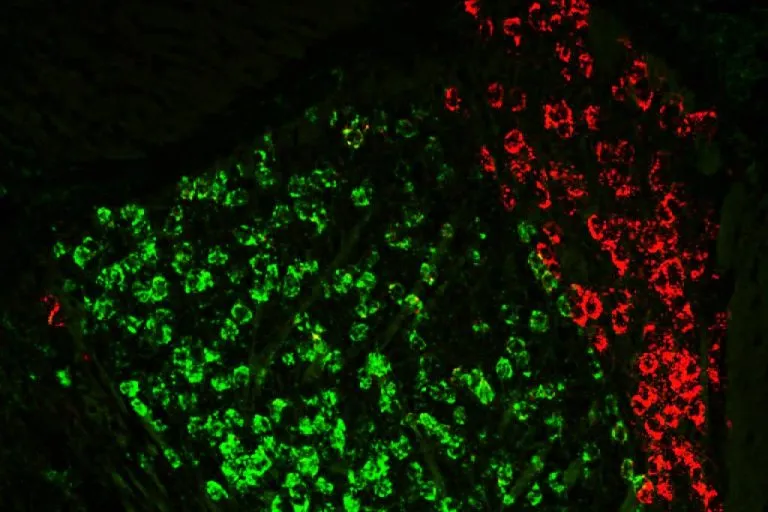With age, people's working memory tends to deteriorate, making it more difficult to perform daily tasks A key brain region associated with this type of memory is the anterior thalamic nucleus, which is mainly involved in spatial memory - memories of our surroundings and how to navigate them

In a recent mouse study, MIT researchers identified a circuit in the anterior thalamic nucleus that is necessary to remember how to navigate through a maze. The scientists also found that this circuit was damaged in older mice, but increased activity significantly improved their ability to run the maze correctly.
According to the researchers, this area may be a good therapeutic target to help reverse memory loss in older people without affecting other parts of the brain.
"By understanding how the thalamus controls cortical output, we hope we can find more specific and medicinal targets in this area, rather than generally regulating the prefrontal cortex with many different functions," said James W. and Patricia t. poitras, Professor of brain and cognitive science at MIT, a member of the broad Institute at Harvard University and MIT, and deputy director of the McGovern Brain Institute at MIT
Feng Guoping is a senior author of the study, which was published in [proceedings of the National Academy of Sciences] on May 25( https://www.pnas.org/doi/10.1073/pnas.2118712119 ) 》Come on. Dheeraj Roy, winner of the National Institutes of health K99 award and McGovern researcher at the broad Institute, and Ying Zhang, J. Douglas Tan postdoctoral researcher at the McGovern Institute, are the main authors of the paper.
Spatial memory
The thalamus is a small structure located near the center of the brain that contributes to working memory and many other executive functions, such as planning and attention. Feng Guoping's laboratory has recently been studying a region of the thalamus, the anterior thalamic nucleus, which plays an important role in memory and spatial navigation.
Previous studies on mice have shown that the damage of anterior thalamic nucleus leads to the damage of spatial working memory. In humans, studies have shown an age-related decline in the activity of the anterior thalamic nucleus, which is associated with low performance in spatial memory tasks.
The anterior thalamic nucleus is divided into three parts: anterior ventral nucleus, anterior medial nucleus and anterior dorsal nucleus. In a study published last year, the same group of researchers analyzed the role of the anterior dorsal nucleus and the anterior ventral nucleus thalamus in memory formation. They found that the anterior dorsal nucleus was involved in creating psychological maps of physical space, while the anterior ventral nucleus helped the brain distinguish these memories from other similar spatial memories.
In their new study, the researchers hope to take a deeper look at the optic thalamus and explore its role in spatial working memory tasks. To do this, they trained mice to run a simple T-maze. At the beginning of each experiment, the mice ran all the way to the T-shape, and one channel was blocked, forcing them to run along the other channel. Then, the mice were placed in the maze again, and both channels were opened. If the mice chose the opposite channel to their first run, they were rewarded. This means that in order to make the right decision, they must remember the direction they turned in the previous run.
When mice performed tasks, the researchers used optogenetics to inhibit the activity of neurons in the anterior dorsal nucleus of three different parts of the task: the sampling phase, which occurred during the first run; Delay phase, when they wait for the second run to start; And the selection phase, when the mouse decides which side to turn on the second run.
The researchers found that inhibition of atrioventricular neurons during the sampling or selection phase had no effect on the performance of mice, but when they inhibited atrioventricular activity in the delayed phase (lasting 10 seconds or more), the task performance of mice was much worse.
This shows that audiovisual neurons are the most important to keep information in the mind when the task needs it. On the contrary, inhibition of neurons in the anterior dorsal nucleus destroys the performance in the sampling stage, but has little effect in the delayed stage. This finding is consistent with the team's earlier study, which showed that neurons in the anterior dorsal nucleus were involved in the formation of physical space memory.
"Generally speaking, the anterior thalamic nucleus is a spatial learning area, but in this maintenance period, in this short delay period, ventral neurons seem to be needed," Roy said. "Now we have two zones in the anterior thalamic nucleus: one seems to contribute to background learning and the other actually helps to maintain this information."
Age related decline
The researchers then tested the effect of age on the circuit. They found that older mice (14 months) performed poorly in the T-maze task and had lower excitability of atrioventricular neurons. However, when the researchers artificially stimulated these neurons, the performance of mice in the task improved significantly.
Another way to improve the performance of this memory task is to stimulate the prefrontal cortex, which also experiences age-related decline. However, the researchers found that activation of the prefrontal cortex also increased the level of anxiety in mice.
"If we directly activate neurons in the medial prefrontal cortex, it will also cause anxiety related behavior, but this will not happen during the activation of the anterior ventral nucleus. This is an advantage of activating the anterior ventral nucleus compared with the prefrontal cortex," Zhang Ying said
If a non-invasive or minimally invasive technique could be used to stimulate these neurons in the human brain, it could provide a way to help prevent age-related memory decline, the researchers said. They are now planning to sequence single-cell RNA from neurons in the anterior thalamic nucleus to find genetic features that can be used to identify cells that will be the best targets.